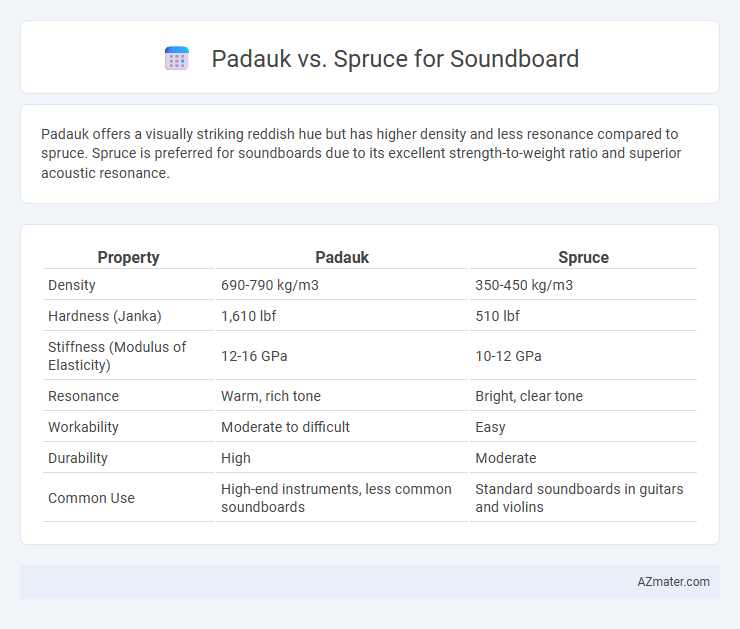Padauk offers a visually striking reddish hue but has higher density and less resonance compared to spruce. Spruce is preferred for soundboards due to its excellent strength-to-weight ratio and superior acoustic resonance.
Table of Comparison
| Property | Padauk | Spruce |
|---|---|---|
| Density | 690-790 kg/m3 | 350-450 kg/m3 |
| Hardness (Janka) | 1,610 lbf | 510 lbf |
| Stiffness (Modulus of Elasticity) | 12-16 GPa | 10-12 GPa |
| Resonance | Warm, rich tone | Bright, clear tone |
| Workability | Moderate to difficult | Easy |
| Durability | High | Moderate |
| Common Use | High-end instruments, less common soundboards | Standard soundboards in guitars and violins |
Introduction to Padauk and Spruce Soundboards
Padauk soundboards offer distinctive tonal warmth and rich midrange frequencies, making them ideal for producing vibrant acoustic textures. Spruce soundboards are renowned for their exceptional strength-to-weight ratio, delivering bright, clear sound with fast response and excellent resonance. Both woods serve crucial roles in instrument construction, with Padauk enhancing tonal complexity and Spruce providing superior projection and clarity.
Botanical Background: Padauk vs Spruce
Padauk, belonging to the Pterocarpus genus in the Fabaceae family, is a tropical hardwood known for its vibrant reddish-orange hue and dense grain structure. Spruce, a softwood from the Picea genus in the Pinaceae family, features a pale color and a straight, fine grain, prized for its exceptional resonance and lightweight properties. The botanical differences between Padauk and Spruce influence their acoustic qualities, with Spruce favored for soundboards due to its superior stiffness-to-weight ratio and Padauk used more for decorative or structural elements in musical instruments.
Tone Characteristics: Warmth vs Brightness
Padauk wood delivers a warm, rich tone with pronounced midrange frequencies, making it ideal for soundboards that emphasize depth and resonance. Spruce, renowned for its bright, clear sound, offers superior projection and crisp articulation, favored in classical and acoustic guitars for its dynamic response. The tonal contrast between Padauk's warmth and Spruce's brightness allows musicians to choose based on desired sound character and musical style.
Physical Properties and Density Comparison
Padauk features a density of approximately 720 kg/m3, offering a strong, durable soundboard material with excellent dimensional stability and resistance to moisture. Spruce, with a lower density ranging from 380 to 450 kg/m3, provides superior elasticity and a lighter weight, enhancing resonance and sound projection in string instruments. The denser Padauk produces a warmer, darker tone, while the lighter Spruce delivers brighter, more transparent acoustics favored in traditional soundboard construction.
Durability and Longevity of Each Wood
Padauk offers exceptional durability for soundboards, with dense grain that resists wear and moisture, ensuring long-lasting structural integrity. Spruce, favored for its exceptional elasticity and resilience, provides excellent longevity by maintaining tonal stability under varying humidity and pressure conditions. Both woods support extended soundboard life, but Padauk excels in resistance to physical damage while Spruce delivers superior acoustic endurance.
Workability and Construction Challenges
Padauk offers excellent durability and a vibrant reddish hue but can pose workability challenges due to its hardness and tendency to blunt tools quickly, making it less ideal for intricate soundboard designs. Spruce, favored in soundboard construction, provides superior resonance and ease of machining, attributed to its lightweight and straight grain, which reduces construction difficulties and enhances tonal quality. While spruce requires careful moisture control to prevent warping, its overall workability simplifies shaping and joining processes compared to the dense, oily nature of padauk.
Cost and Availability in the Market
Padauk soundboards are generally more expensive than spruce due to limited supply and exotic wood status, with prices varying based on grain quality and thickness. Spruce remains the most cost-effective and widely available choice, favored for its consistent availability from sustainable sources and competitive market pricing. Both materials have strong market presence, but spruce dominates in affordability and ease of procurement for soundboard manufacturing.
Aesthetic Differences: Color and Grain
Padauk soundboards display a vibrant reddish-orange hue that deepens over time, offering a bold and eye-catching appearance, while spruce soundboards feature a pale cream to light yellow color with subtle golden tones, contributing to a classic and understated aesthetic. The grain of padauk tends to be tight and interlocked with a visible, textured surface that enhances visual richness, contrasted with spruce's straight, uniform grain that provides a clean, smooth, and consistent look. These distinctive color and grain characteristics influence the instrument's visual appeal, with padauk bringing warmth and intensity, and spruce delivering elegance and simplicity.
Popularity Among Luthiers and Musicians
Padauk and spruce are both favored for soundboards, with spruce maintaining greater popularity among luthiers and musicians due to its bright tonal clarity and strong projection. Padauk offers a unique, warm midrange and striking reddish hues, garnering niche appeal in custom guitars and experimental instruments. The widespread use of Sitka spruce in high-end acoustic guitars underscores its status as the industry standard for reliable resonance and balanced sound.
Conclusion: Choosing the Right Soundboard Wood
Padauk offers vibrant midrange tones with excellent durability, making it ideal for instruments requiring strong projection and stability. Spruce is renowned for its superior resonance and balanced tonal clarity, favored in classical guitars and violins for responsive soundboards. Selecting between Padauk and Spruce depends on the desired tonal character and instrument use, with Spruce excelling in traditional acoustic settings and Padauk providing unique warmth and robustness.

Infographic: Padauk vs Spruce for Soundboard
 azmater.com
azmater.com